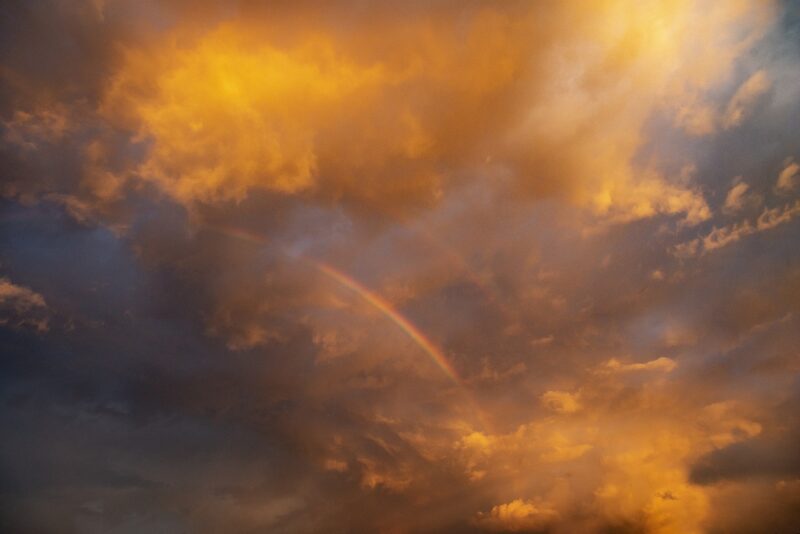
Rainbows are among the most enchanting natural phenomena that captivate our senses, bringing a splash of color after a storm and inspiring countless myths and legends. However, when we encounter a rare double rainbow, the experience becomes even more magical, sparking curiosity about the science behind this breathtaking sight. In this article, we will delve into what double rainbows are, how they form, and why they’re so infrequently seen.
1. Understanding the Basics of a Rainbow
Before we dive into double rainbows, let’s first grasp how a standard rainbow forms. A rainbow occurs when sunlight refracts, reflects, and disperses through water droplets in the atmosphere, leading to a spectrum of colors in the sky. This phenomenon is a result of several key elements:
- Refraction: As sunlight passes through a raindrop, it bends. This bending occurs because light travels at different speeds in air than in water.
- Reflection: After refraction, the light reflects off the inside surface of the droplet.
- Dispersion: Different colors of light bend at slightly different angles, creating a spectrum when they exit the raindrop.
The result is a circular arc of colors typically ranging from red on the outside to violet on the inside.
2. The Science Behind Double Rainbows
Now that we understand how a single rainbow forms, we can explore the creation of a double rainbow.
In the case of a double rainbow, the process is similar but involves two reflections of light inside the raindrop:
- First Rainbow: The first rainbow forms from the standard single reflection of light, which produces the bright and vivid arc that we commonly see.
- Second Rainbow: The second rainbow arises from light reflecting twice within the raindrop before exiting. Due to the additional reflection, this rainbow appears fainter and its color order is reversed, with red on the inside and violet on the outer edge.
This phenomenon occurs at a specific angle known as the angle of deviation. For the primary rainbow, this angle is approximately 42 degrees, while for the secondary rainbow, it is around 50 degrees. The second rainbow’s fainter appearance is due to the light’s dispersion over multiple reflections, leading to less intense color vibrancy compared to the first.
3. Conditions for Viewing Double Rainbows
Seeing a double rainbow is rare and requires specific conditions to be met:
- Sunlight and Rain: The most common scenario occurs when rain is falling in one part of the sky while the sun shines in another, creating a contrast of light and dark areas. This is known as a ‘sunshine shower.’
- Low Sun Angle: Double rainbows are more visible when the sun is low in the sky, such as early in the morning or late in the afternoon. A lower solar angle allows for the optimal viewing position to the observer.
- Water Droplets Size: The size of the raindrops can also influence the visibility of double rainbows. Larger droplets lead to clearer, more vibrant rainbows due to more effective light refraction and reflection.
These factors combined create a delicate balance necessary for witnessing one of nature’s most spectacular displays.
4. The Rarity of Double Rainbows
Though capturing the beauty of a double rainbow is thrilling, their rarity prompts us to ask: why don’t we see them more often?
Several factors contribute to the infrequency of double rainbows:
- Environmental Conditions: Obtaining the right balance of sunlight and rain in the correct geographic area can be challenging. Weather patterns must align perfectly to create the ideal conditions for viewing double rainbows.
- Light Pollution: In urban areas, light pollution can wash out the visibility of celestial phenomena, making it harder to see vibrant colors of rainbows, especially double rainbows.
- Time and Patience: Observers must be in the right place at the right time, armed with patience to witness this fleeting spectacle that lasts only as long as the unique weather conditions remain intact.
Because of these challenges, when a double rainbow does appear, it often leaves those lucky enough to witness it in awe, highlighting the beauty of nature’s artwork.
5. Cultural Significance and Folklore
Double rainbows have not only fascinated scientists but have also intrigued cultures throughout history. Various societies have incorporated rainbows into their folklore and beliefs:
- Symbol of Hope: Across many cultures, rainbows are viewed as a symbol of hope and promise, often marking a transition from hardship to happiness. A double rainbow intensifies this message, symbolizing twice the hope and joy.
- Mythical Significance: In some traditions, double rainbows are said to connect the earth to the heavens, representing a bridge between the physical realm and the spiritual world. They have been seen as an omen or a sign of profound change on the horizon.
- Connection to Treasure: Perhaps the most famous folklore involving rainbows comes from the Irish legend of leprechauns hiding their pots of gold at the end of a rainbow. A double rainbow inverts this idea, reinforcing the concept that one can attain even greater fortunes or treasures in the face of rarity and beauty.
The rich tapestry of beliefs surrounding double rainbows illustrates humanity’s enduring fascination with nature and our desire to seek deeper meanings in extraordinary sights.
Conclusion
Double rainbows are a stunning and rare manifestation of nature that beckons us into an exploration of meteorological wonders. From their formation through sunlight and water droplets to the ideal weather conditions required for their visibility, understanding double rainbows enchants both the curious viewer and the scientific mind.
Whether you’re an avid nature enthusiast or someone who simply enjoys the occasional rainstorm, keep an eye on the skies. The next time conditions allow, you might just witness a brilliant double rainbow, a rare and beautiful spectacle reminding us of the wonders that exist in our world. As we continue to explore our natural surroundings, let the phenomenon of double rainbows inspire us to appreciate the small joys amidst life’s storms.








